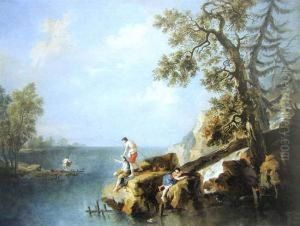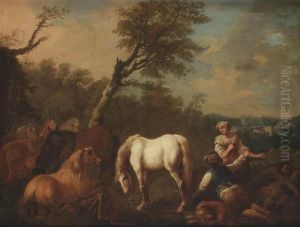Francesco Zuccarellego Paintings
Francesco Zuccarelli was an influential Italian artist known primarily for his pastoral landscapes that embodied the idyllic Arcadian tradition. Born on August 15, 1702, in Pitigliano, Tuscany, Zuccarelli showed an early talent for painting, which led him to study in Rome, where he was deeply influenced by the works of French landscape painters Claude Lorrain and Gaspard Dughet, whose classical landscapes set the standard for the genre. However, Zuccarelli’s style also incorporated the lightness and color palette characteristic of the Rococo movement, making his works distinctive and highly sought after.
Zuccarelli’s career took him across Italy, including significant periods in Venice, where he became associated with the Venetian school of painting. His landscapes, often featuring pastoral scenes with shepherds, classical ruins, and serene rivers, were not only appreciated for their aesthetic beauty but also for their ability to evoke a peaceful, Arcadian world. In Venice, he became a founding member of the Venetian Academy in 1756, which affirmed his status as one of the leading painters in the city.
The artist’s reputation extended beyond Italy, attracting the attention of patrons in England, where he lived and worked for several periods throughout his life. In England, Zuccarelli’s patrons included royalty and prominent members of society, reinforcing his international acclaim. His landscapes were particularly admired for their picturesque qualities and contributed to the English landscape gardening movement.
Despite his success, Zuccarelli’s work was sometimes criticized for its perceived lack of depth and over-reliance on idyllic themes. Nevertheless, his influence on the development of landscape painting in the 18th century, particularly in Italy and England, is undeniable. He was also a mentor to younger artists, passing on his techniques and stylistic preferences to the next generation.
Francesco Zuccarelli returned to Italy in his later years, where he continued to paint until his death on December 30, 1788, in Florence. Today, his works are held in numerous prestigious collections worldwide, including the Uffizi in Florence and the Royal Collection in the United Kingdom, attesting to his enduring legacy in the history of art.

